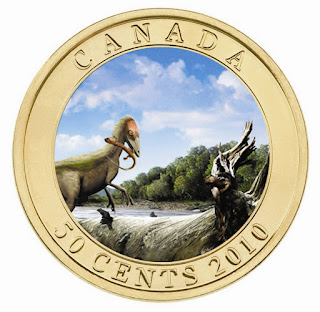Canada Coins 50 Cents 2010 Sinosauropteryx
Lenticular Coin
Dinosaur Exhibit Series
The third issue of the Dinosaur Exhibit Series. The Royal Canadian Mint teams up with Canada’s museums to create this new series of must-have dinosaur coins, each inspired by a different exhibit.
Sinosauropteryx is just one of many amazing dinosaur fossils on display in The Talisman Energy Fossil Gallery – a fierce prehistoric carnivore that will spring to action with a slight tilt of the coin. It's presented in a full-colour folder that also includes six trading cards that will fascinate and engage amateur dinosaur hunters and enthusiasts alike – a terrific keepsake! Trading cards feature Panoplosaurus, Chasmosaurus irvinensis, Chasmosaurus russelli, Leptoceratops, Triceratops and Daspletosaurus torosus.
This coin features a captivating motion effect by combining vibrant colour and the Mint’s leading-edge lenticular technology. Its unusual brass-plated composition and distinctive specimen finish elevate its status as a collectible keepsake.
Obverse: Susanna Blunt’s design of Her Majesty Queen Elizabeth II.
Reverse: Sinosauropteryx.
Diameter: 35 mm
Weight: 12.9 g
Face value: 50 Cents.
Manufacturer: Royal Canadian Mint.
Dinosaur Exhibit Series
Canada Coins 50 Cents 2010 Sinosauropteryx - Dinosaur Exhibit Series
Sinosauropteryx
Sinosauropteryx (meaning "Chinese reptilian wing", Chinese: pinyin: Zhōnghuá lóng niǎo; literally: "China dragon bird") is a compsognathid dinosaur. Described in 1996, it was the first dinosaur taxon outside of Avialae (birds and their immediate relatives) to be found with evidence of feathers. It was covered with a coat of very simple filament-like feathers. Structures that indicate colouration have also been preserved in some of its feathers, which makes Sinosauropteryx the first non-avialian dinosaurs where colouration has been determined. The colouration includes a reddish and light banded tail. Some contention has arisen with an alternative interpretation of the filamentous impression as remains of collagen fibres, but this has not been widely accepted.
Sinosauropteryx was a small theropod with an unusually long tail and short arms. The longest known specimen reaches up to 1.07 metres (3.5 feet) in length, with an estimated weight of 0.55 kilograms (1.2 pounds) It was a close relative of the similar but older genus Compsognathus, both genera belonging to the family Compsognathidae. Only one species of Sinosauropteryx has been named: S. prima, meaning "first" in reference to its status as the first feathered non-avialian dinosaur species discovered. Three specimens have been described. The third specimen previously assigned to this genus represents either a second, as-yet unnamed species or a distinct, related genus.
Sinosauropteryx lived in what is now northeastern China during the early Cretaceous period. It was among the first dinosaurs discovered from the Yixian Formation in Liaoning Province, and was a member of the Jehol Biota. Well-preserved fossils of this species illustrate many aspects of its biology, such as its diet and reproduction.


